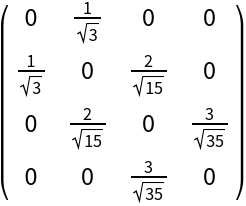Wolfram Function Repository
Instant-use add-on functions for the Wolfram Language
Function Repository Resource:
Generate the Jacobi matrix corresponding to an orthogonal polynomial
ResourceFunction["JacobiMatrix"][n,poly] yields the nth order Jacobi matrix corresponding to the orthogonal polynomial pn(x) represented by poly. |
| "ChebyshevFirst" | Chebyshev polynomial of the first kind ChebyshevT[n,x] |
| "ChebyshevSecond" | Chebyshev polynomial of the second kind ChebyshevU[n,x] |
| "Hermite" | Hermite polynomial HermiteH[n,x] |
| "Laguerre" | Laguerre polynomial LaguerreL[n,x] |
| "Legendre" | Legendre polynomial LegendreP[n,x] |
| {"Gegenbauer",m} | Gegenbauer polynomial GegenbauerC[n,m,z] |
| {"Laguerre",a} | associated Laguerre polynomial LaguerreL[n,a,x] |
| {"Jacobi",a,b} | Jacobi polynomial JacobiP[n,a,b,x] |
The Jacobi matrix corresponding to a Legendre polynomial:
| In[1]:= |
|
| Out[1]= |

|
Jacobi matrix of a Jacobi polynomial with symbolic parameters:
| In[2]:= |
|
| Out[2]= |

|
An equivalent specification:
| In[3]:= |
|
| Out[3]= |

|
Symmetric and unsymmetric Jacobi matrices for an associated Laguerre polynomial:
| In[4]:= |
![MatrixForm /@ {ResourceFunction["JacobiMatrix"][
4, {"Laguerre", \[Alpha]}, "Symmetric" -> True], ResourceFunction["JacobiMatrix"][4, {"Laguerre", \[Alpha]}, "Symmetric" -> False]}](https://www.wolframcloud.com/obj/resourcesystem/images/4c9/4c9b41c3-b03b-4570-89e0-89ad1ebadf23/28ab511075dd63bf.png)
|
| Out[4]= |

|
Find the roots of an orthogonal polynomial by computing the eigenvalues of a Jacobi matrix:
| In[5]:= |
|
| Out[5]= |
|
Compare with the result of using NSolve:
| In[6]:= |
|
| Out[6]= |
|
The characteristic polynomial of a Jacobi matrix is a scalar multiple of the associated orthogonal polynomial:
| In[7]:= |
|
| Out[7]= |
|
| In[8]:= |
|
| Out[8]= |
|
The unsymmetric and symmetric Jacobi matrices are related to each other through a similarity transformation:
| In[9]:= |
![m1 = ResourceFunction["JacobiMatrix"][4, LaguerreL, "Symmetric" -> True];
m2 = ResourceFunction["JacobiMatrix"][4, LaguerreL, "Symmetric" -> False];
With[{d = FoldList[Times, 1, Normal@Diagonal[m1, 1]]}, m1 == DiagonalMatrix[d] . m2 . DiagonalMatrix[1/d]]](https://www.wolframcloud.com/obj/resourcesystem/images/4c9/4c9b41c3-b03b-4570-89e0-89ad1ebadf23/755c9ec44357d826.png)
|
| Out[9]= |
|
This work is licensed under a Creative Commons Attribution 4.0 International License